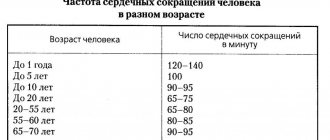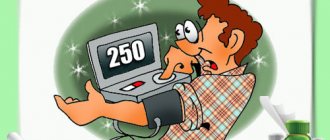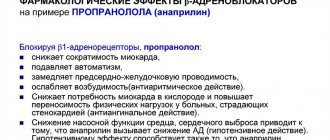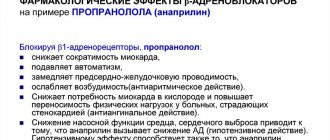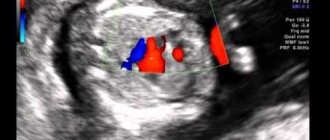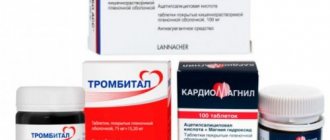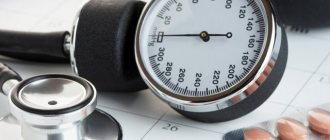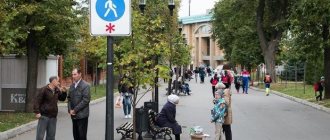Nowadays, many people have problems with the functioning of the cardiovascular system. Often, with these pathologies, the heart rate increases - the pulse increases. Doctors distinguish between physiological and pathological increases in heart rate, so if a person suspects that his heart is not working properly, it is better for him to immediately consult a doctor.
Alexander Yuryevich Shishonin, a general practitioner, candidate of sciences, specialist in the field of cardiovascular diseases, and organizer of the “Club of Former Hypertensive Patients,” talks about pulse rates and why people develop tachycardia.
Blood thinners
Antithrombotic drugs are used for various cardiac diseases to prevent blood clots, heart attack or stroke.
For palpitations, they are prescribed if atrial fibrillation (atrial fibrillation) is diagnosed. In this case, chaotic contractions of the atria create conditions for the “churning” of blood clots inside them, which can enter the arterial bed and clog a large vessel feeding an organ. Antithrombotic drugs do not have the property of slowing heart rate.
For atrial fibrillation, the following medications are prescribed to prevent severe complications:
- warfarin;
- a combination of acetylsalicylic acid and clopidogrel (in extremely rare cases, if it is impossible to use other means);
- dabigatran etexilate (Pradaxa);
- apixaban (Eliquis);
- rivaroxaban (Xarelto).
These medications are not prescribed to all patients. There are strict conditions for their use, so independent use of such drugs is unacceptable.
We recommend reading about arrhythmia and bradycardia at the same time. You will learn about the types and causes of arrhythmia against the background of bradycardia, signs of arrhythmia and bradycardia, as well as treatment for bradycardia with arrhythmia.
And here is more information about Anaprilin for arrhythmia.
Anti-palpitation pills are selected by a cardiologist individually for each patient. Despite the variety of relevant medications, a limited number of medications are used to treat each type of arrhythmia. Treatment for palpitations should be carried out under the control of daily ECG monitoring, and self-administration of such drugs is unacceptable.
Common causes of heart palpitations
Even a healthy person can feel increased heartbeat. This is most common for people with increased nervous sensitivity. The following can lead to heart palpitations:
- significant physical effort;
- rapid rise to altitude;
- physical activity in a hot and stuffy environment (lack of oxygen leads to increased heart function);
- sharp mental stress (fear, excitement, etc.);
- consuming large amounts of foods high in caffeine (coffee, tea, Coca-Cola);
- certain medications (in particular, cold remedies);
- digestive disorders (for example, flatulence, as a result of which the diaphragm appears slightly elevated).
Palpitations may be felt when the temperature is high (patients with a fever often feel palpitations).
Microelements for the heart with tachycardia
Vitamins and minerals have a strong impact on the functioning of the cardiovascular system. Micronutrient deficiency very often causes tachycardia and arrhythmia. Therefore, to prevent the development of such a situation, drugs for tachycardia are used in the form of vitamin and mineral complexes. Minerals are responsible for the functioning of the heart and blood vessels:
- magnesium, which prevent blood clots by normalizing metabolic processes and controlling blood viscosity;
- calcium, which normalizes myocardial contractile function;
- phosphorus – a conductor of nerve impulses;
- selenium, which increases local immunity, providing protection to heart cells and blood vessels;
- potassium that accompanies the generated electrical impulse through the myocardial conduction system.
Diagnostic methods
- Electrocardiography (ECG). After examining the printout, the doctor will be able to determine the type of tachycardia and see, for example, heart failure.
- Daily Holter monitoring is intended to detect paroxysmal tachycardia. Electrodes are attached to the baby's skin and connected to a compact device that takes readings around the clock. Sometimes it takes more than a day.
- Ultrasound of the heart (Echo-CG) - allows you to see the structure of the heart, structural abnormalities, visualize large vessels and heart valves and chambers, the thickness of the walls of the organ, and evaluate its contractile function. Ultrasound allows you to see heart defects.
- A clinical blood test aimed at detecting anemia. With it, a compensatory acceleration of heart rate occurs.
- Biochemical blood test for glucose levels and electrolyte composition.
- Blood test for thyroid hormones.
- Electroencephalography (EEG).
- MRI of the heart - in rare cases.
- Electrophysiological study (EPS) of the heart is necessary to evaluate electrical activity and find the source of impulses in the paroxysmal type of tachycardia.
Emergency care for tachycardia
At home, if tachycardia occurs, the following measures are taken:
- you need to take a horizontal position,
- you can drink a sedative of herbal origin,
- If the patient has previously had an attack of tachycardia, the cause is known and the patient has recommendations for treatment, then you can take the medicine that was prescribed by the doctor to stop the tachycardia.
If the measures taken do not lead to restoration of the heart rhythm, then it is necessary to call an ambulance.
What to do if a child has an attack of tachycardia before the doctors arrive?
Until the ambulance arrives, there are several ways to alleviate the child’s condition:
The most important thing is to calm the child down, open a window or vent so that fresh air can enter the room. The following measures can then be taken:
- Wipe the child's face with cold water, and then place a cloth soaked in cold water on his face.
- Have your child close his eyes and then gently apply pressure to his eyeballs for a few seconds. This will provoke a reflex in which the heart rate decreases.
- Perform a Valsalva maneuver - the child should close his mouth and nose tightly and strain as if he wants to exhale.
- Massage the carotid sinus, that is, the place where the carotid artery divides into two branches - external and internal. This place is located approximately where the thyroid cartilage is on both sides of the neck. It’s easy to feel the thyroid cartilage; in men it’s called the “Adam’s apple.” After this, move your fingers slightly downward, and immediately under the Adam’s apple you will feel the carotid sinus with a characteristic pulsation. Apply pressure and massage for a few minutes. Source: L.A. Balykova, I.S. Nazarova, A.N. Silence Treatment of cardiac arrhythmias in children // Practical Medicine, September 2011, No. (53), pp. 30-37
Low blood pressure with tachycardia
First aid is as follows:
- you need to lie down and raise your legs,
- drink sweet tea. The use of coffee and caffeinated drinks is prohibited,
- take a deep breath and hold your breath for a while,
- It is possible to use sedatives - motherwort tincture.
If the condition does not improve, lethargy, weakness, and dizziness appear, then it is necessary to urgently call an ambulance.
The hospital will conduct a set of necessary examinations to determine the cause of tachycardia due to hypotension. Based on the data obtained during diagnosis, a diagnosis is made and a treatment plan is prescribed.
Treatment is mainly aimed at eliminating the etiological factor that caused the increased heart rate. The complex of treatment measures also includes taking vitamins and physiotherapeutic procedures.
- Tachycardia folk treatment - healthy lifestyle recipes
How to measure pulse?
Heart rate can be measured at different points: at the temples, in the neck or in the heart area. However, the easiest way to do this is on the wrist. It is better to determine the pulse rate on the right hand, since it can be better felt there. The number of beats must be measured for 10 seconds, then the result obtained is multiplied by 6. Thus, the average heart rate is established.
Review of drugs for tachycardia
Medications are prescribed to normalize the pulse and control heart contractions. When choosing the most effective remedy, the doctor takes into account the degree of progression of the disease, the presence of other pathologies and contraindications. Therapy is carried out under outpatient supervision of a specialist.
When the heart rate increases, it is necessary to take suitable antiarrhythmic drugs, which are divided into several groups. Drug therapy is prescribed individually for each patient.
Membrane stabilizing
The body’s reaction to membrane-stabilizing drugs is that the heart begins to beat more slowly. This is due to a disruption in the transport of potassium, sodium and calcium ions, which is achieved under the influence of the active components included in the preparations. In this case, there is a decrease in excitability and a weakening of contractions.
Among the most effective remedies for high pulse membrane-stabilizing action are:
- " Metostabil " (oral pulse tablets) - the dosage is gradually increased from 125-250 mg until a therapeutic effect is obtained. It is not recommended to take during pregnancy, lactation, or with liver and kidney failure.
- “ Etatsizin ” - you need to take tablets for tachycardia 50 mg three times a day. If the expected result is not achieved, the dosage is increased. You can take no more than 300 mg per day, divided into 3 doses. The drug is not recommended for myocardial hypertrophy, in the post-infarction state and for children under 18 years of age.
- “ Novocainamide ” - drink 0.25-1.00 g every 3-6 hours. If there is no result, the dosage is increased to 3 mg per day. Contraindications include heart failure, myocardial infarction and renal failure.
Beta blockers
Medicines developed on the basis of substances that block adrenergic receptors. Such drugs are used for hypertension because they affect the functioning of the nervous system. Beta blockers relieve pain in the heart and protect against atherosclerosis.
The action of the drugs is aimed at reducing the myocardial oxygen demand to reduce heart rate and support coronary blood flow. The active substances included in the composition prevent the formation of blood clots and the progression of the pathological process. The use of beta blockers reduces the incidence of heart attacks and reduces the likelihood of sudden death.
Cardiac glycosides (CG) to reduce heart rate
The pharmacological effect of cardiac glycosides is to change the basic functions of the heart. Under their influence, heart contractions increase, which leads to an increase in the volume of blood thrown into the aorta. The heart rate slows down, which increases blood flow to the heart ventricles.
The effect that SGs have on blood pressure is variable. With normal blood pressure levels, no changes are observed with the use of cardiac glycosides. The drugs have a pronounced calming effect on the central nervous system (CNS).
Cardiac glycosides that are prescribed for tachycardia:
- Sinus bradycardia in children: root causes of development, ECG signs, treatment
- "Digoxin";
- "Strophanthin";
- "Korglikon".
Classification of bradycardia
The work of the heart is impossible without the normal functioning of the conduction system. These are special muscle fibers that form nodes and bundles and provide coordinated contraction of the atria and ventricles of the heart. A normal rhythm is generated with a frequency of 60–90 per minute in the sinus node (SU), which is located in the right atrium. Along the internodal bundles, the electrical impulse is conducted to the atrioventricular node (atrioventricular - AV), located in the interatrial septum. From the AV node, the impulse goes directly to the muscles that provide contraction of the ventricles of the heart.
Depending on the mechanism of occurrence, bradycardia occurs:
- Sinus. Associated with a slowdown in impulse generation in the sinus node itself (Fig. 3).
- Sinoatrial, in which the transmission of impulses from the sinus to the atria is blocked.
- Atrioventricular, when there is a blockade of excitation transmission in the AV node.
Figure 3. Development of sinus bradycardia.
Source: mayoclinic.org Bradycardia can be pathological and physiological - a decrease in heart rate is typical for young athletes and during sleep. Pathological bradycardia occurs:
- acute and chronic;
- with symptoms and without clinical manifestations;
- cardiac and extracardiac (depending on the reasons).
Possible consequences
A rare pulse (40–45 beats/min) is dangerous for the patient when high blood pressure is recorded, as it leads to the development of hypoxia. Oxygen starvation provokes a disorder of cerebral circulation, resulting in destructive changes in the vascular system of the brain.
Frequent attacks of bradycardia increase the risk of blood clots, since slow blood circulation contributes to its stagnation in the heart chambers. Blood clots that have formed in the heart can migrate to any vessel, causing blockage.
Diagnostic measures
In order to diagnose bradycardia, the general clinical picture is studied: a person’s lifestyle, his complaints, and accompanying symptoms. A cardiac examination is required to identify possible heart pathologies. The doctor analyzes information about the medications the person is taking and compares the electrocardiogram data with other indicators obtained as a result of laboratory tests and examinations. The classic Holter method or weekly monitoring of the heart rhythm using a special mobile device can be used.
The first signs of disorder
With a slight dissonance between pressure and pulse, patients identify the main complaints of symptoms characteristic of hypertension. However, pronounced deviations from normal indicators cause a deterioration in the general condition.
An attack of dizziness against the background of a sharp decrease in heart rate can cause fainting
Characteristic signs of the pathological condition are:
- Dizziness (lack of oxygen supply to brain tissue).
- Dyspnea (disorder of normal gas exchange in the pulmonary system).
- Weakness (insufficient blood supply to muscle tissue leads to insufficient contraction).
- Severe fatigue (impaired metabolic reactions contribute to a deficiency of energy reserves in muscle cells and the accumulation of special chemicals in them).
- Pain behind the sternum (occurs with a significant decrease in the pulse rate).
All signs indicate the development of concomitant pathologies, and therefore require very strict monitoring and additional diagnostics from specialists.
Symptoms of bradycardia
Manifestations of bradycardia are caused by a lack of blood supply to vital organs: the brain, heart and lungs. Bradycardia can manifest itself (Fig. 4):
- decrease in blood pressure;
- presyncope and loss of consciousness;
- dizziness, headache;
- rapid fatigue;
- chest pain;
- shortness of breath and poor tolerance to any physical activity;
- pale skin.
Figure 4. Symptoms of bradycardia. Source: MedPortal
Prevention
To prevent complications of bradycardia, you need to consult a specialist as soon as possible if your pulse decreases and heart rate is less than 60, and undergo a full examination to identify the causes of the condition. It is equally important to strictly follow your doctor's recommendations for treating episodic or prolonged bradycardia.
To prevent bradycardia, it is necessary to adhere to a lifestyle that reduces the risk of heart disease:
- stop smoking and drinking alcohol;
- eat well: limit animal fats, salt, caloric content of food should correspond to energy costs;
- reduce excess weight if you are overweight;
- avoid nervous stress;
- normalize blood pressure.
